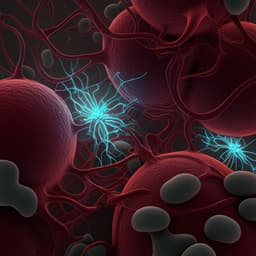
Agriculture
Agrobacterium expressing a type III secretion system delivers Pseudomonas effectors into plant cells to enhance transformation
V. Raman, C. M. Rojas, et al.
This groundbreaking research conducted by Vidhyavathi Raman, Clemencia M. Rojas, and their team engineered Agrobacterium tumefaciens to enhance plant transformation efficiency significantly. By incorporating a type III secretion system, they achieved remarkable increases in the transformation of wheat, alfalfa, and switchgrass, along with successful delivery of plant proteins, paving the way for advancements in agricultural biotechnology.
Playback language: English
Introduction
Agrobacterium tumefaciens, a soil-borne phytopathogen, causes crown gall disease by transferring its DNA (T-DNA) and virulence proteins into plant cells using a type IV secretion system (T4SS). This T-DNA transfer mechanism is widely utilized in plant biotechnology to generate transgenic plants. However, a significant limitation is the low transformation efficiency observed in many plant species and varieties. This recalcitrance is largely attributed to the activation of plant defense mechanisms against Agrobacterium infection.
Plant defense against microbial pathogens involves a multi-layered innate immune system. The first layer, PAMP-triggered immunity (PTI), is initiated by the recognition of conserved microbial molecules (PAMPs) by pattern recognition receptors (PRRs) on the plant cell surface. This recognition triggers a cascade of signaling events leading to defense responses that often restrict pathogen growth. Agrobacterium's abundant protein, elongation factor thermo unstable (EF-Tu), acts as a PAMP, triggering PTI via the Arabidopsis PRR EF-TU receptor (EFR), which subsequently reduces Agrobacterium-mediated plant transformation (AMT). Arabidopsis efr mutants exhibit increased susceptibility to AMT, highlighting the importance of PTI in hindering transformation.
In contrast to Agrobacterium's T4SS, many Gram-negative plant pathogenic bacteria utilize a type III secretion system (T3SS) to directly deliver effector proteins (T3Es) into host cells. These T3Es often function as virulence factors, interfering with host cellular processes and suppressing PTI, allowing the bacteria to overcome plant defenses and establish infection. T3SSs are complex macromolecular machines that form a needle-like structure, enabling the direct delivery of effectors across bacterial and plant cell membranes. The genes encoding the T3SS apparatus are conserved and functional even when expressed heterologously. For instance, the T3SS from Pseudomonas syringae pv. syringae 61 (*Pss61*) has been successfully expressed in non-pathogenic bacteria like Pseudomonas fluorescens and Escherichia coli, allowing them to deliver proteins into plants.
Many T3Es, such as AvrPto from P. syringae pv. tomato, suppress plant basal defense. AvrPto's interaction with the kinase domains of PRRs FLS2 and EFR leads to PTI suppression. Previous studies demonstrated that inducible expression of AvrPto in Arabidopsis enhances transient AMT, and transient expression via co-infiltration improves transient transgene expression in Brassica sp. Plants with compromised plant defense mechanisms show increased susceptibility to AMT. While reducing plant defense responses can increase AMT, this approach is impractical for field applications due to the need to generate transgenic plants. Alternatively, manipulating the expression of host factors, like histones, involved in transformation and regeneration has been attempted, but this also requires transgenic approaches.
This research proposes a novel strategy: engineering Agrobacterium tumefaciens with a T3SS to deliver proteins that either suppress plant defense or enhance transformation efficiency. The study investigates the efficacy of this strategy using Pseudomonas syringae pv. tomato T3Es (AvrPto, AvrPtoB, HopAO1) and the plant protein histone H2A-1, delivered along with T-DNA using engineered A. tumefaciens. The hypothesis is that these protein deliveries will enhance transformation efficiency in various plant species.
Literature Review
The existing literature extensively details the challenges of Agrobacterium-mediated plant transformation (AMT), primarily due to the activation of plant defense responses. The role of PAMP-triggered immunity (PTI) and the specific involvement of the EFR receptor in recognizing Agrobacterium's EF-Tu protein as a PAMP have been well-established. Studies on the use of Arabidopsis efr mutants have highlighted the importance of suppressing PTI to improve transformation efficiency. The use of type III secretion systems (T3SS) by various plant pathogens and the mechanisms by which they deliver effector proteins (T3Es) into plant cells to suppress PTI and promote infection have also been thoroughly investigated. AvrPto, a well-studied T3E from Pseudomonas syringae, has shown promise in suppressing plant immunity and improving transformation. Previous work explored the effects of AvrPto and other effectors on transient AMT in Arabidopsis and Brassica, demonstrating improved transformation when plant defense responses are compromised. However, previous attempts to use T3Es to increase stable transformation and methods focused on manipulating plant genes, including the role of histones in T-DNA integration, have been limited by the need for transgenic approaches.
Methodology
The study employed several key methodologies to investigate the effect of delivering T3Es and a plant protein (histone H2A-1) via an engineered T3SS in Agrobacterium tumefaciens on plant transformation efficiency.
**1. Engineering Agrobacterium with a T3SS:** The T3SS gene cluster from Pseudomonas syringae pv. syringae 61 (Pss61) was cloned into Agrobacterium tumefaciens strains (GV2260, EHA105, A208, AGL1), creating strains capable of expressing and secreting T3Es.
**2. Effector Delivery Verification:** To confirm the functionality of the engineered T3SS, several assays were employed:
* **Secretion Assay:** Immunoblotting was used to detect the presence of fluorescently-tagged effectors (AvrPto-PhiLOV) in both the cell pellet and supernatant fractions of Agrobacterium cultures. The presence in the supernatant indicated successful secretion of the effector proteins.
* **In Planta Visualization:** A split GFP system was used to visualize the delivery of effectors (AvrPto-GFP11) into plant cells (Nicotiana benthamiana). Infiltrating leaves with Agrobacterium strains expressing GFP1-10 and a second strain expressing AvrPto-GFP11 resulted in the reconstitution of functional GFP only when the T3SS was present and active, demonstrating effector translocation into plant cells. FM4-64 staining confirmed the plasma membrane localization of delivered effectors.
**3. Transient and Stable Transformation Assays:** Various transformation assays were conducted on different plant species, including Arabidopsis, Nicotiana benthamiana, wheat, alfalfa and switchgrass. This included:
* **Arabidopsis transient transformation:** Leaves were infiltrated with Agrobacterium strains expressing different T3Es along with a GUS reporter gene to assess transient transformation efficiency. GUS activity was measured using both histochemical staining and fluorometric assays.
* **Arabidopsis stable transformation:** Arabidopsis root transformation and root callus assays were performed using Agrobacterium strains to evaluate the effect on stable transformation efficiency. The root tumor assay used tumorigenic Agrobacterium strains, while a callus assay used non-tumorigenic strains with a selectable marker gene (bar) to quantify stable transformation efficiency.
* **Nicotiana benthamiana transformation:** Similar transient and stable transformation assays using leaf infiltration and leaf disk tumor assays were conducted on N. benthamiana.
* **Crop plant transformation:** Wheat, alfalfa, and switchgrass transformation protocols were used for stable transformation assays. These assays involved immature embryos for wheat, leaf segments for alfalfa and calli for switchgrass to investigate the impact of the engineered Agrobacterium on transformation efficiency in crop plants.
**4. Virulence Gene Expression Analysis:** Reverse transcription-quantitative PCR (RT-qPCR) was used to assess the expression levels of various Agrobacterium virulence (vir) genes in engineered strains with and without T3SS and T3E expression. This analysis aimed to determine if the increase in transformation efficiency was due to increased virulence gene expression.
**5. Plant Defense Gene Expression Analysis:** To examine the effect of delivered AvrPto on plant defense responses, RT-qPCR was performed to measure the expression levels of plant defense marker genes (FRK1 and NHL10) in Arabidopsis roots infected with Agrobacterium strains with and without the T3SS and AvrPto.
**6. Plant Protein Delivery and Transformation Enhancement:** Similar transformation assays were conducted using Agrobacterium strains expressing plant histone H2A-1 or a truncated version (tHTA1) fused with type III secretion signals from AvrRpm1 or AvrRps4, to evaluate the impact of delivering a plant protein involved in transformation on transformation efficiency.
Key Findings
The study's key findings demonstrate the successful development and application of a novel strategy for enhancing Agrobacterium-mediated plant transformation (AMT) by engineering Agrobacterium tumefaciens to express a Pseudomonas syringae type III secretion system (T3SS) and deliver effectors and plant proteins into plant cells.
**1. Functional T3SS in Agrobacterium:** The Pss61 T3SS was successfully expressed and functioned in Agrobacterium, allowing for the secretion and translocation of various T3Es (AvrPto, AvrPtoB, HopAO1) into plant cells. The use of fluorescent reporters (PhiLOV, GFP) allowed for visualization of effector delivery.
**2. Enhanced Transformation Efficiency:** The co-delivery of T3Es (AvrPto, AvrPtoB, HopAO1) via the engineered T3SS significantly increased both transient and stable transformation efficiency in various plant species, including Arabidopsis, Nicotiana benthamiana, wheat, alfalfa and switchgrass. The improvements ranged from a 2-fold increase in Arabidopsis floral dip transformation to a 400% increase in switchgrass transformation. The increase was most significant in recalcitrant species like wheat.
**3. No Change in Virulence Gene Expression:** RT-qPCR analysis revealed no significant difference in the expression of Agrobacterium virulence (vir) genes between engineered strains with and without T3SS and T3E expression, suggesting that the increased transformation efficiency is not a result of increased bacterial virulence but rather due to the suppression of plant defenses.
**4. Suppression of Plant Defense Responses:** Analysis of plant defense gene expression in Arabidopsis roots showed a significant reduction in the expression of PTI marker genes (FRK1 and NHL10) upon infection with engineered Agrobacterium strains expressing AvrPto, indicating a suppression of plant immune responses which could contribute to higher transformation efficiency.
**5. Successful Plant Protein Delivery:** Delivery of the plant protein histone H2A-1 (and tHTA1), a known factor in T-DNA integration, through the engineered T3SS also significantly increased stable transformation efficiency in both model and crop plants, confirming the versatility of the T3SS-mediated delivery system.
Discussion
This study demonstrates a novel approach to overcome the limitations of Agrobacterium-mediated plant transformation (AMT) by leveraging the type III secretion system (T3SS) to deliver plant defense suppressors and enhance transformation-related proteins directly into plant cells. The significant increase in transformation efficiency observed across various plant species, especially in recalcitrant species like wheat, highlights the potential of this technology. The finding that the enhanced transformation efficiency is not a result of increased virulence but rather suppression of plant defense responses and efficient protein delivery provides strong evidence for the mechanism of action. The successful delivery of a plant protein, histone H2A-1, further strengthens the versatility of this approach, paving the way for exploring other factors that could enhance transformation. This technology offers a significant advancement in plant biotechnology, with potential applications in generating transgenic and genome-edited crops, particularly for recalcitrant species.
Conclusion
This research successfully demonstrates a novel method for significantly enhancing Agrobacterium-mediated plant transformation by using an engineered T3SS to deliver proteins that suppress plant defenses or enhance transformation. This approach successfully increased transformation efficiency across various plant species, including recalcitrant crops like wheat, alfalfa and switchgrass. This technology holds promise for advancing plant biotechnology and generating transgenic or genome-edited crops, particularly overcoming limitations in species recalcitrant to traditional transformation methods. Future research should explore the delivery of additional plant factors involved in transformation and regeneration, as well as optimization of the T3SS system for delivering larger proteins and improving efficiency further.
Limitations
The study primarily focused on the delivery of a limited set of effector proteins and histone H2A-1. Further research is needed to assess the effectiveness of delivering a broader range of proteins and to explore the optimal combinations of effectors and proteins for different plant species. While the study demonstrated a significant increase in transformation efficiency, it might be necessary to optimize the transformation protocols for specific species or cultivars to further maximize the effects of T3SS-mediated protein delivery. The long-term effects of the delivered proteins on plant development and overall plant health also require further investigation.
Related Publications
Explore these studies to deepen your understanding of the subject.







